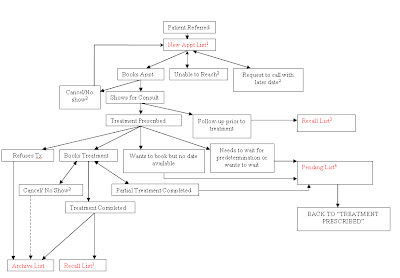Everdream asked me to blog about Lean nursing practices.
Disclaimer
Our clinics are the equivalent of a ‘surgi-centre’ with both consultative appointments and procedures under anaesthetics. While I’ve been staff at hospitals for years, I have never supervised a floor lean initiative. I have supervised many clinic lean initiatives with our own 20+ nursing staff. For a framework of lean initiatives click
here and
here and
here.
Semantics
Normally I consider initiatives that decrease repetition of a task Six Sigma and initiatives that decrease either the time or variation in time of a task Lean. I think most of us would agree that there is a continuum so all of the listed changes are ‘Lean Six Sigma’.
Goals
Time with the patient
Better Quality of Care
All the nursing initiatives are to increase time with the patient. In our minds, that means defining projects that are relatively small and well defined. They must not create more daily work for the staff. Nurses are not administrators but clinicians. Their time with the patient is at least as important as the doctors.
One of the reasons we never completed ISO9000 was our concern that the paperwork would overshadow the goals of quality improvement. In the same vain, we try not to let lean initiatives distract from the ultimate goal. For instance, endless meetings or daily paperwork that is burdensome are not part of initiatives.
The rest of this blog describes some of the short initiatives we’ve undertaken.
Contacting Doctors
As far as I’m concerned this is the biggest waste of time for nurses. Even in our clinics nurses could spend an hour a day trying to c contact various doctors. In 2002 installed an email server (Exchange) in-house and in 2005 a Blackberry BES Server. The network was necessary and the small additional expense in administration was more than compensated for in nursing time. Now, unless it is urgent, the nurses can simply email the question or request rather than trying to hunt down the doctors. It is not uncommon for me to get an email while talking with a patient from a nurse that is 20 feet down the hall.
When needed for patient in the clinic the nurses also had to search the office to let the doctor know the patient was ready. When we increased the size of the office this had the potential to become a major problem. Now, rather than trying to hunt us down, they will call our desk and if not there page us. Instead of waiting several minutes x 30 patients a day they can move on to the next patient and keep the system flowing.
Equipment:
Sundry Items
The quintessential nursing lean initiative is decreasing how much they walk. I can still remember a friend being asked to wear a pedometer in 1982. We set up each room identically so items are easy to find. We also ‘double stock’ each room with quickly used sundry items (gloves, masks, etc…). Each will have the item in use and a back up. When one runs out they can immediately use the next to save time having to search.
Placing Equipment
When designing our current building consideration was given to the location of the central supply (we are a 20,000 clinic). Central supply houses items used for each case and is centrally located. A supply room holds a weekly supply of materials in the basement.
Broken EquipmentBroken equipment used to go through 2 levels of management before replacement. They would give the part to a supervisor who would give it to the manger who would ok the order. Ironically the nurse was often the one ordering the part anyway. Now the nurses contact the supplier directly and have it ordered for routine repairs. Common items are ECG leads and saturation probes.
Out of Date EquipmentCertain items expire but are rarely used (e.g. defibrillator pads). The expiry date is now kept with the drug expire dates and checked weekly on a checklist
Cost Control
With increased stocking comes an increased cost. Rather than trying to control sundry item cost from the outset we stocked the rooms to maximize efficiency with the patient then re-created our stocking system for ‘just in time’ delivery of most times so that supply costs didn’t spiral out of control. I’ve found this to be a constant battle between preventing a zero-outage and minimizing stock in the basement. It is still a work in progress.
Standardized Training and References (Skills, Knowledge, Judgment)
Uncertainty on what to do in the first two years of the job was common. In 2001 we initiated a standardized training (on-the-job) program for nurses with 2 week, 1 month, 6 month and 2 year goals. Although logic predicts learning should come in the order of knowledge, skill, judgment we’ve found practically that skills, knowledge, judgment is easier to learn. The first month is focused on the basic skills, the next 6 on knowledge and the first 2 years on advanced skills and knowledge. We’ve now added standardized references to the package so nurses have less hunting to do for information. Items include written emergency procedures, common drug monographs, and written basic skills.
Tomorrow I’ll blog about emergency drills, standardized histories, standing orders and cross coverage by ancillary services.









